- [WJ-R]: 1980s object removal (Castlethorpe/Hanslope area)
- [XCS]: Pending
- [UkTrainSys]: v0.3.2.0 released
- [Object Library]: Preparing...
- [Website]: Fifth version of website launched
 My openBVE videos and other comments from users and
myself can also be found via my YouTube
channel.
My openBVE videos and other comments from users and
myself can also be found via my YouTube
channel.Blog and Progress Updates
openBVE v1.0.7.1 released; performance improvements and new object development features
Posted by admin on June 16, 2009 at 12:04 amopenBVE v1.0.7.1 is now available; I’d recommend heading over to the » openBVE homepage « to download the latest stable release, and don’t forget to read the » Changelog « for a full list of alterations and new features.
![]() Update (18th June): openBVE v1.0.7.2 was released yesterday. This version includes a bugfix relating to problems when some objects were loaded, which also resulted in error messages. As far as I’m aware, the objects concerned were those with meshbuilder blocks containing both Cylinder commands and AddFace commands referencing the cylinder’s vertices, which should now be loaded without any problems in v1.0.7.2.
Update (18th June): openBVE v1.0.7.2 was released yesterday. This version includes a bugfix relating to problems when some objects were loaded, which also resulted in error messages. As far as I’m aware, the objects concerned were those with meshbuilder blocks containing both Cylinder commands and AddFace commands referencing the cylinder’s vertices, which should now be loaded without any problems in v1.0.7.2.
This release can offer some potentially superb performance improvements on some routes. With Cross-City South v1.31.02, and 8x antialiasing/16x anisotropic filtering set via my graphics card drivers, along with bilinear interpolation set via openBVE’s options, I see between 20-35% increases in framerates compared to openBVE v1.0.6.2 with identical settings. With anisotropic filtering and smooth transparency enabled via openBVE’s settings, I also see between around 25-46% increases in framerates with identical settings in both openBVE versions. So for example, where the entrance to Birmingham New Street used to take me down to 15 fps with smooth transparency enabled, now I can reach a much more fluid 21-22 fps. I won’t publish any figures regarding Cross-City South v1.4 yet, as the route is still in development and the performance level changes often as I experiment with it. These results are obtained on an AMD Athlon 64 X2 4200+ @ 2.2GHz, 2GB DDR2-800 CL5-5-5-15, ATi Radeon HD 2600 Pro 256MB DDR2 PCIe equipped system by the way.
The improvement which has most impressed me though, is the performance of openBVE v1.0.7.1 with Watford Junction to Rugby. To say that I’m delighted would be a massive understatement, as I’ve seen between 30-160% increases in framerate compared to v1.0.6.2! Generally though, framerates of around 17-21 fps (on the four track sections between stations, in the external view with those nice AC electric and Mk2 coach objects) are now fairly typical, where around 11-14 fps was a typical range before. Framerates are higher when in the cab view, of course. Certain extremely detailed areas which still need to be simplified for openBVE 1’s renderer, like the Bourne End and New Ledburn Junctions, as well as Tring and Bletchley, are now handled much better as well (10-12 fps rather than 4-6 fps as it was before, with framerates recovering to normal levels after passing through these isolated locations). To put this in perspective, the route loads around 2600 objects of all types with over 72600 .Freeobj commands, which is a lot more than usually found in a BVE route, and this is over a 106 km distance (in comparison, Cross-City South v1.31 loads around 700 objects of all types, with around 5600 .Freeobj commands over around a 25 km distance). In BVE 4, the framerate may be comparable initially, but if I start driving from Watford Junction, it stutters frequently, and BVE 4’s renderer gives up after reaching Kings Langley just a few kilometres into the route, and BVE 4 crashes without even an error message shortly after; WJ-R is a long way past being suitable for BVE 4 now, hence an awful lot of stuff will need to be removed in the BVE Trainsim versions of the route.
These latest openBVE optimisations which give rise to improvements in framerates, may also mean that route loading times increase a little as the object geometry is optimised, although in practice, I’m finding that only 5-6 seconds are added to Cross-City South v1.4 / new class 323 loading times, and 9 seconds added to Watford Junction to Rugby’s loading time, bringing the total loading time to 39 seconds for the latter route. Nevertheless, if this is a problem for you, please read » this thread « for information about the hidden options which enable you to limit what the new object optimiser does, allowing for faster loading times, but naturally at the expense of in-game performance.
If you’re interested in how these performance improvements have been implemented, take a look at » michelle’s blog « where the relevant OpenGL concepts are discussed (the May and June 2009 pages). Essentially, OpenGL’s GL_TRIANGLE_STRIP and GL_QUAD_STRIP structures are now used along with GL_POLYGON structures which were used exclusively in prior versions of openBVE, and using these structures where possible means that fewer vertices need to be transmitted to the rendering pipeline (due to there being fewer effectively duplicated vertices), thereby improving performance. These other structures are generated automatically by the new object optimiser included in v1.0.7, which was written for openBVE 2’s engine but has been added to openBVE 1. Version 2 of openBVE should deliver even greater performance improvements however, thanks to the use of display lists rather than the immediate mode currently used.
This early performance improvement also means that I can capture some higher resolution video of Watford Junction to Rugby now, so come back soon as I’m preparing another of my YouTube videos, in which I’ll also show a couple of other things I’ve been working on. 🙂
New Object Development Features
Two new features have been added which allow developers greater flexibility and functionality where object creation is concerned — the Shear / ShearAll commands, and the ability to specify vertex normals in B3D and CSV objects (previously, vertex normals could only be specified in .X objects, which were awkward to hand edit). Before experimenting, please make sure that you’ve downloaded the latest versions of » openBVE«, » Object Viewer « and » Route Viewer « (if necessary, clear your browser cache first to ensure you aren’t just getting older versions of the downloads from your hard disk cache instead of the webserver).
Shear and ShearAll
Using the Shear / ShearAll commands, we can now skew meshes or entire objects, which makes certain kinds of objects much quicker and easier to create. Take a bridge which crosses a railway at an angle for example; designing the bridge object such that it’s perpendicular to the railway is relatively easy, but creating it at an angle can be more time consuming, especially if the bridge includes an arch. Using the new commands, we can create the bridge in a perpendicular fashion, and then easily perform a shear mapping operation on all the vertices in either a MeshBuilder block or the entire object:
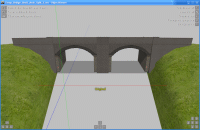 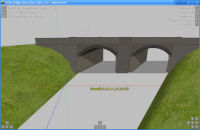 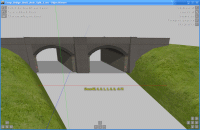 |
These results are created with the following commands added right at the end of the object file:
|
ShearAll, 0, 0, 1, 1, 0, 0, 0.75
or…
ShearAll, 0, 0, 1, 1, 0, 0, -0.75
|
Please see the relevant openBVE documentation » here « for more information about these commands and the parameters.
Vertex Normals
If you’ve used the Cylinder command in your objects, you’ll probably have noticed that the resulting collection of faces were smoothly shaded. Creating any other mesh however, resulted in flat shading. If the object was converted to the .X format, it was possible to manually hand edit the vertex normals to smoothly shade faces, but due to the nature of the format this wasn’t user friendly, and wasn’t possible at all in B3D or CSV format objects. Now though, what I think is an easy way to apply vertex normals and smooth shading to meshes has been implemented. Take the following screenshots:
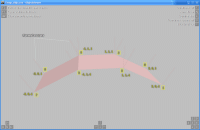 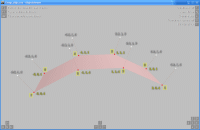 |
On the left, we have a simple mesh with 8 vertices and 3 faces:
|
CreateMeshBuilder
AddVertex, 3, 0, 1, ;vertex 0 AddVertex, 3, 0,-1, ;vertex 1 AddVertex, 1, 1, 1, ;vertex 2 AddVertex, 1, 1,-1, ;vertex 3 AddVertex,-1, 1, 1, ;vertex 4 AddVertex,-1, 1,-1, ;vertex 5 AddVertex,-3, 0, 1, ;vertex 6 AddVertex,-3, 0,-1, ;vertex 7 AddFace,0,1,3,2 AddFace,2,3,5,4 AddFace,4,5,7,6 SetColor,190,160,160 |
On the right, we have the same mesh, but with vertex normals specified, resulting in the smoothly shaded appearance:
|
CreateMeshBuilder
AddVertex, 3, 0, 1, 0.6, 1, 0 AddVertex, 3, 0,-1, 0.6, 1, 0 AddVertex, 1, 1, 1, 0.3, 1, 0 AddVertex, 1, 1,-1, 0.3, 1, 0 AddVertex,-1, 1, 1,-0.3, 1, 0 AddVertex,-1, 1,-1,-0.3, 1, 0 AddVertex,-3, 0, 1,-0.6, 1, 0 AddVertex,-3, 0,-1,-0.6, 1, 0 AddFace,0,1,3,2 AddFace,2,3,5,4 AddFace,4,5,7,6 SetColor,190,160,160 |
In the first annotated Object Viewer screenshot, you can see that the automatically generated normals are depicted via the vector lines emanating from the vertices (you can view these by pressing the N key within Object Viewer). Note also the flat shading, and how this relates to the direction of the normal vectors. In the second screenshot however, which shows the same mesh with manually defined normals, smooth shading is now applied, and vertices 2, 3, 4 and 5 now have one normal vector each, affecting all faces that share those vertices. You can see that each normal vector is created relative to the associated vertex coordinates.
To give some examples of where to use this feature, the ability specify normals allows me to, for example, reduce the number of faces on a curved surface to improve performance in some circumstances, or smoothly shade the grass embankments shown in the bridge screenshots above, or the curved surfaces of locomotives and rolling stock:
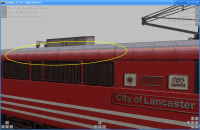 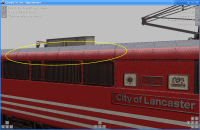 |
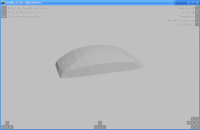 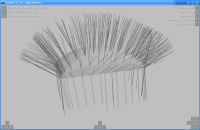 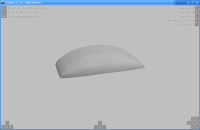 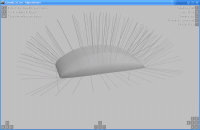 |
Finally, for the more technically minded amongst us, openBVE’s debug output layout (viewable via the F10 key) has been revamped and contains some interesting extra data relating to the number of each different face type in use:
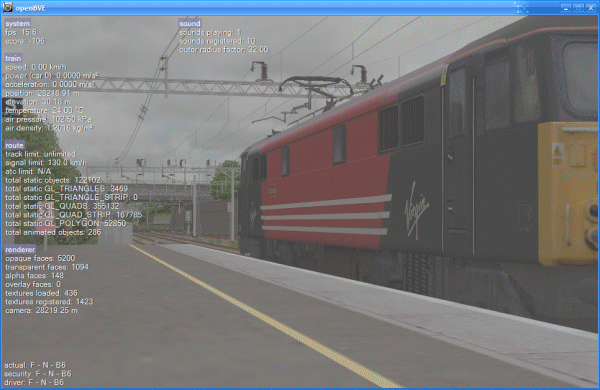 |
Tags: Cross-City South, Hardware, openBVE, Screenshots, Watford Jn to Rugby

where do you download it can you give me a specific link??
You just need to visit http://openbve.trainsimcentral.co.uk/downloads.html and click the Download button next to “The full program (excluding external dependencies)” further down the page. You can then visit http://openbve.trainsimcentral.co.uk/use/download_windows.html for instructions on obtaining the dependencies (DLLs) required by openBVE.
Please let me know if you want any further assistance with these latter steps. 🙂
Excellent post!
http://img9.imageshack.us/i/notnormalvertex.png/
http://img200.imageshack.us/i/normalvertexnext.png/
[…] Rail Sim Routes 的網誌上找到: openBVE v1.0.7.1 released; performance improvements and new object development features 本篇發表於 openBVE 官方消息, 消息 並標籤為 openBVE, openBVE […]